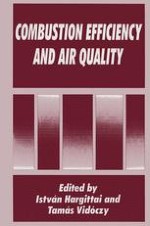1995 | OriginalPaper | Chapter
Concentrations of Combustion Particulates in Outdoor and Indoor Environments
Authors : Alfred H. Lowrey, Lance A. Wallace, Sándor Kántor, James L. Repace
Published in: Combustion Efficiency and Air Quality
Publisher: Springer US
Included in: Professional Book Archive
Activate our intelligent search to find suitable subject content or patents.
Select sections of text to find matching patents with Artificial Intelligence. powered by
Select sections of text to find additional relevant content using AI-assisted search. powered by
Human exposure to combustion particulates is a risk imposed on society justified by the need for the beneficial uses of energy. The respiratory system is the major route for this exposure in the form of airborne suspensions (aerosols) of these particles (U.S. EPA, 1982). Like Prometheus (Fig. 1), we find ourselves chained to the rock of the essential benefits of combustion while at the same time suffering the deterioration of the internal human systems necessary for life support. It is common knowledge that particle exposure, particularly from combustion, is a source of lung disease. In broad terms, outdoor particulates exhibit a bimodal size distribution ((U.S. EPA, 1986a) consisting of fine particles (less than 2.5 μm in diameter, with peak size concentration about 0.9 p.m) and coarse particles (> 2.5 μm in diameter with peak concentrations in the size range of 10-20 μ.m). Figure 2 illustrates this distribution, indicating some of the common constituents in each size range. The coarse particles include reentrained surface dust, salt spray, and particles formed by mechanical processes such as crushing and grinding. Particles from combustion general fall into the fine range and occur in two size categories: condensation nuclei and accumulation mode. The condensation nuclei are generally considered to range in size from 0.005 to 0.05 μm in diameter and result from cooling condensation of vapors or plasmas produced by high-temperature processes in combustion. Accumulation mode particles generally range from 0.5 to 2.0 μm in diameter and form principally by coagulation or are grown through vapor condensation of short-lived particles originally in the nuclei mode. Particles in the accumulation mode normally do not grow into the size range of the coarse mode ((U.S. EPA, 1986a). It is well known that fine particles evade the natural defenses of the human respiratory tract. Often this fraction of exposure is designated respirable suspended particulates (RSP) to distinguish this feature from exposure to the total quantity of suspended particulates (TSP). In 1987, the U.S. Environmental Protection Agency (EPA) introduced new annual and 24-hour standards for particulate matter, using a new indicator, PM10, that includes only those particles with an aerodynamic diameter smaller than 10 μm ((U.S. EPA, 1991). An additional measure, PM2.5, was also developed that includes only particles smaller than 2.5 μm in diameter.
